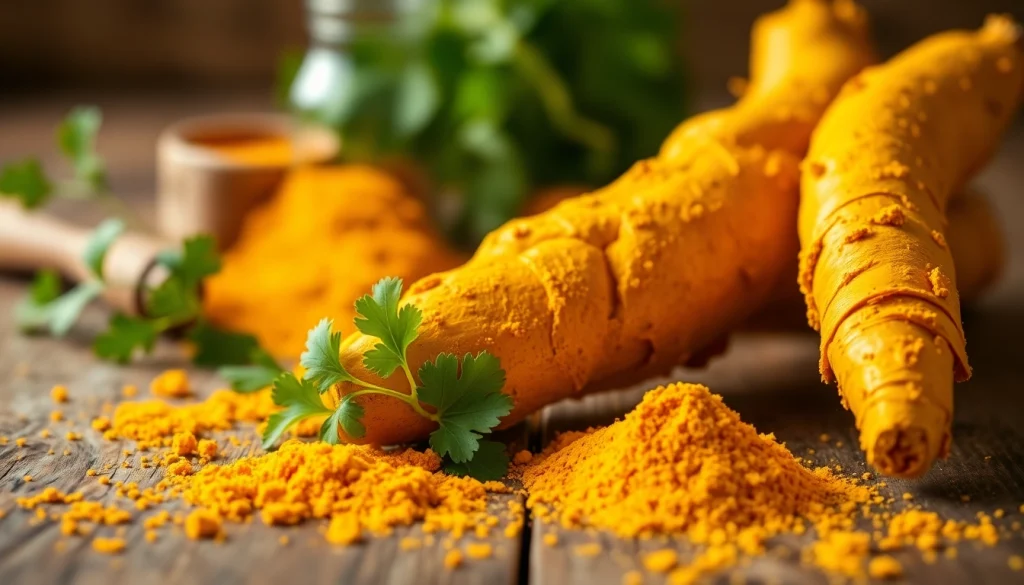The Power of Turmeric Root: An Introduction
Turmeric root, a vibrant yellow-orange rhizome, belongs to the ginger family and has been a staple in Asian cuisine and medicine for centuries. Known scientifically as Curcuma longa, this root has garnered global attention for its myriad of health benefits and culinary uses. From its historical roots in Ayurvedic medicine to its popularity as a modern-day superfood, turmeric is celebrated not only for its flavor but also for its impressive medicinal properties. In this comprehensive guide, we will explore everything you need to know about turmeric root, including its background, health benefits, practical usage in the kitchen, and its role in wellness and beauty.
What is Turmeric Root? An Overview
Turmeric root is the underground stem (rhizome) of the turmeric plant, which is native to Southeast Asia. Its vibrant color and distinctive flavor have made it an essential ingredient in various dishes, particularly those in Indian and Middle Eastern cuisines. Being part of the ginger family, turmeric shares some culinary characteristics with its more famous relative. However, what sets turmeric apart are its high concentrations of bioactive compounds, most notably curcumin.
Curcumin is the primary active ingredient in turmeric, accounting for its health benefits. This polyphenol not only gives turmeric its characteristic yellow color but also possesses remarkable anti-inflammatory and antioxidant properties. Known in traditional medicine for centuries, turmeric’s significance has been validated by modern scientific research, which continues to explore its extensive therapeutic potential.
Historical Significance of Turmeric in Medicine
Historically, turmeric has been used for thousands of years in traditional Ayurvedic and Chinese medicines. Ancient texts indicate its use for detoxification and digestive support. Turmeric was also employed in treating skin ailments, infections, and inflammatory conditions. In India, turmeric has been considered a symbol of purity and fertility, often used in weddings and religious ceremonies.
Modern research has sought to elucidate the mechanisms behind turmeric’s healing properties. Investigations have found that curcumin can modulate various biological pathways, impacting inflammation, oxidative stress, and even cancer progression. Its ability to enhance the immune response and protect against chronic diseases highlights the importance of turmeric in both traditional and contemporary health practices.
Popular Varieties and Types of Turmeric Root
While there are numerous species of turmeric, the most commonly used variety is Curcuma longa. This golden root can be consumed fresh or dried, and each form offers distinct benefits. Fresh turmeric has a more potent flavor and is often used in juices and smoothies, while dried turmeric in powdered form is essential for cooking and health supplements.
Other varieties, such as Curcuma zedoaria (white turmeric) and Curcuma aromatica (wild turmeric), have also gained attention, although their use is less common. These varieties possess unique properties and can be utilized in various applications, from culinary to medicinal.
Health Benefits of Turmeric Root
Anti-Inflammatory Properties of Turmeric Root
One of the most significant benefits of turmeric root lies in its anti-inflammatory effects. Chronic inflammation is linked to a host of diseases, including heart disease, cancer, and neurodegenerative conditions. Curcumin inhibits various molecules known to play major roles in inflammation, including cytokines and enzymes. Several clinical trials have substantiated turmeric’s potency, proving that it can effectively reduce inflammation in conditions such as arthritis and inflammatory bowel disease.
A landmark study published in the Journal of Alternative and Complementary Medicine indicated that curcumin supplementation can lead to notable improvements in joint pain and function in patients with rheumatoid arthritis. The results echo the findings of various other research endeavors which have explored turmeric’s potential as a natural anti-inflammatory alternative to traditional pharmaceutical treatments.
Antioxidant Benefits of Curcumin in Turmeric Root
Aside from its anti-inflammatory properties, curcumin acts as a powerful antioxidant. Free radicals within the body can cause oxidative stress, which impacts cellular integrity and is implicated in aging and numerous diseases. Curcumin’s molecular structure allows it to neutralize free radicals, thereby protecting cells from damage.
The turmeric root has shown significant promise in enhancing the body’s antioxidant defense mechanism. A study published in the American Journal of Medicine outlined that curcumin supplementation could increase glutathione levels, one of the body’s most critical antioxidant molecules. Regular consumption of turmeric may help decrease the risk of chronic diseases linked to oxidative stress, promoting overall longevity.
Potential Effects on Chronic Diseases
Research has illuminated turmeric’s potential role in combating chronic diseases. The benefits extend well beyond inflammation and oxidation. Studies have suggested that curcumin can affect insulin sensitivity, making it a potential ally against type 2 diabetes. Its effects on cholesterol levels and blood pressure regulation also point to its heart health benefits.
Furthermore, preliminary research indicates that curcumin may hold potential in cancer prevention and therapy. Various cancer studies have found that curcumin can inhibit the proliferation of cancer cells and induce apoptosis (programmed cell death) in various cancer types, including breast, prostate, and colorectal cancers.
Although further research is required to solidify these findings, the promising data leads to a strong case for integrating turmeric into a health-conscious lifestyle and diet.
How to Incorporate Turmeric Root into Your Diet
Delicious Recipes Featuring Fresh Turmeric Root
Integrating turmeric root into your diet is not only beneficial but can also be delicious. Here are a few recipes that showcase the unique flavor and health benefits of turmeric:
- Turmeric Ginger Tea: Boil fresh turmeric and ginger slices in water, strain, and add lemon juice and honey for a soothing herbal drink.
- Golden Milk: Simmer turmeric with almond milk, a pinch of black pepper, and cinnamon. Sweeten with honey for a delightful evening drink.
- Turmeric Rice: Add grated fresh turmeric to your rice while cooking for a vibrant and flavorful side dish.
Effective Ways to Use Turmeric Root in Smoothies and Juices
Fresh turmeric root can easily be blended into smoothies and juices, adding a nutritional boost:
- Tropical Turmeric Smoothie: Blend fresh pineapple, banana, coconut water, and a small piece of fresh turmeric for a tasty energy boost.
- Green Detox Juice: Combine spinach, cucumber, apple, lemon, ginger, and turmeric in a juicer for a refreshing detoxifying drink.
Dosage Recommendations for Daily Consumption
To reap the health benefits of turmeric root, moderate daily consumption is key. A typical recommendation is about 1-3 grams of fresh turmeric or around 400-600 mg of curcumin supplements taken three times a day, preferably with black pepper, which enhances curcumin absorption. Always consult a healthcare professional for personalized dosage guidance, especially if you are considering high-dose supplements.
Buying and Storing Turmeric Root
Where to Buy Quality Turmeric Root
Quality matters when sourcing turmeric root. Fresh turmeric can be commonly found at health food stores, Asian markets, or organic grocery stores. Online platforms also offer high-quality dried turmeric products, catering to those who prefer convenience. Ensure that the turmeric you purchase is organic to avoid exposure to pesticides.
Tips for Selecting Fresh Turmeric Root
When shopping for fresh turmeric root, look for firm, unblemished rhizomes. The skin should be smooth, and a fresh aroma should be present. Be wary of dried turmeric; check for freshness by observing the color and aroma, ensuring it has not faded or lost its pungency.
Storing Your Turmeric Root for Maximum Freshness
Proper storage is essential to maintain the freshness of turmeric root. Fresh turmeric should be wrapped in a paper towel and placed in a breathable container in the refrigerator, where it can last up to a few weeks. Dried turmeric should be kept in a cool, dark place in an airtight container to protect its potency and flavor.
Exploring Turmeric Root in Wellness and Beauty
The Role of Turmeric Root in Skincare
Turmeric’s skin benefits are well-documented, leading to its inclusion in various skincare products. Its anti-inflammatory properties can help reduce acne and soothe skin conditions like eczema and psoriasis. Additionally, the antioxidant qualities of curcumin make it a valuable ally in fighting signs of aging.
Homemade turmeric face masks, combining turmeric powder with honey or yogurt, can rejuvenate skin and impart a healthy glow. However, always conduct a patch test prior, as some individuals may be sensitive to turmeric.
Turmeric Root in Natural Remedies and Supplements
The versatility of turmeric extends to its use in natural remedies and dietary supplements. From curcumin capsules to turmeric-infused oils, various products are available. Incorporating turmeric root powder in dietary supplements can provide targeted health benefits without the need for excessive amounts of root itself.
Safety, Side Effects, and Precautions with Turmeric Root
While turmeric root is generally recognized as safe for culinary use, excessive consumption can lead to digestive upset or interact with certain medications (such as blood thinners). Pregnant and breastfeeding women, as well as individuals with gallbladder issues, should consult with a healthcare professional before significantly increasing their turmeric intake.
In summary, turmeric root is a powerful natural ingredient with extensive benefits for both health and wellness. Integrating it into your daily routine can contribute to better health, beauty, and overall well-being, making it a worthy inclusion in your pantry and personal care products.



